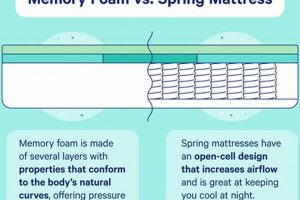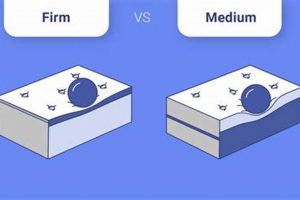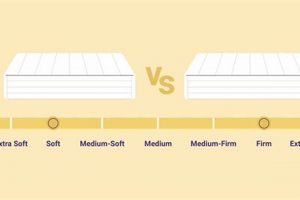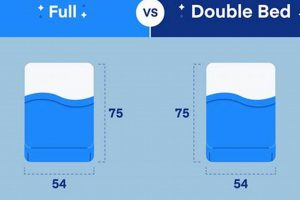A comparison of two distinct mattress brands, Purple and Puffy, forms the basis of this analysis. Each company utilizes different construction and material technologies to achieve distinct comfort and support profiles. Purple mattresses are known for their hyper-elastic polymer grid, while Puffy mattresses are typically constructed with multiple layers of memory foam. A comparison helps consumers determine which option best suits their individual needs and preferences.
Understanding the features of these mattresses is important because sleep quality directly impacts physical and cognitive well-being. Examining the aspects such as pressure relief, motion isolation, temperature regulation, and edge support provides valuable insights. These insights are relevant for individuals experiencing back pain, couples with differing sleep schedules, hot sleepers, and those who require a stable edge for getting in and out of bed. Both brands have risen in prominence in the direct-to-consumer mattress market, offering convenient online purchasing and trial periods.
The subsequent sections will delve into specific comparisons, examining the construction, performance characteristics, pricing, and warranty policies of mattresses from both Purple and Puffy. This detailed examination allows a potential buyer to make an informed decision based on their specific requirements and preferences for a comfortable and supportive sleep surface.
Selecting Between Purple and Puffy Mattresses
This section outlines key factors to consider when deciding between mattresses from these two companies, focusing on optimizing sleep quality and long-term satisfaction.
Tip 1: Evaluate Spinal Alignment Needs: The level of support offered by each mattress impacts spinal alignment. Assess if a firmer, more supportive surface (potentially Purple) or a conforming, pressure-relieving surface (potentially Puffy) aligns better with your sleeping position and any pre-existing back issues.
Tip 2: Analyze Temperature Sensitivity: Memory foam, prevalent in Puffy mattresses, can retain heat. If overheating is a concern, the Purple’s grid structure, designed for airflow, might be a better choice.
Tip 3: Consider Motion Isolation Preferences: Couples sharing a bed should evaluate motion isolation capabilities. Memory foam tends to isolate motion effectively, while the Purple grid might transfer movement more noticeably.
Tip 4: Assess Edge Support Requirements: Individuals who sit on the edge of the bed or require assistance getting in and out should consider edge support. Some mattress constructions offer stronger edge support than others; research the specific model.
Tip 5: Review Trial Periods and Return Policies: Both companies offer trial periods. Thoroughly understand the terms and conditions of the trial, including return shipping costs and refund eligibility, before making a purchase.
Tip 6: Compare Pricing and Available Discounts: Mattress prices vary. Compare the cost of different models and factor in any available discounts or promotional offers. Consider the long-term investment when evaluating price.
Tip 7: Investigate Warranty Coverage: Warranty details protect against manufacturing defects. Review the warranty terms and conditions, including the length of coverage and what is covered, to ensure adequate protection.
Careful consideration of spinal alignment, temperature sensitivity, motion isolation, edge support, trial periods, pricing, and warranty coverage allows for a more informed mattress selection, ultimately contributing to improved sleep quality and overall well-being.
The following sections will provide a summarized conclusion to assist readers in making their choice.
1. Construction Materials
The materials used in manufacturing mattresses directly influence their comfort, support, durability, and overall suitability for individual sleepers. Examining the compositional differences between Purple and Puffy mattresses is essential for understanding their respective performance characteristics.
- Purple’s Hyper-Elastic Polymer Grid
Purple mattresses utilize a proprietary hyper-elastic polymer grid structure as their primary comfort layer. This grid is designed to buckle under pressure, providing targeted support and pressure relief. The open-grid design promotes airflow, mitigating heat retention issues often associated with traditional foam mattresses. Its unique material composition contributes to a distinct feel and responsiveness, diverging significantly from conventional foam-based constructions.
- Puffy’s Multi-Layer Memory Foam System
Puffy mattresses typically incorporate multiple layers of memory foam, each serving a specific purpose. These layers often include a comfort layer for initial plushness, a transition layer for added support, and a base layer for overall stability. Memory foam conforms closely to the body, distributing weight and reducing pressure points. However, its density can limit airflow and potentially lead to increased heat retention compared to grid-based designs.
- Support Core Materials
Both Purple and Puffy mattresses employ support core materials to provide foundational support and durability. Purple often uses high-density polyurethane foam as its support core, while Puffy typically relies on a similar material. The density and thickness of the support core directly impact the mattress’s ability to maintain its shape and prevent sagging over time.
- Cover Fabrics and Materials
The cover fabrics used in mattresses impact breathability and overall feel. Purple often utilizes a soft, breathable knit fabric designed to enhance airflow. Puffy typically employs a similar approach, often incorporating features like stain resistance or cooling properties. The materials and construction of the cover contribute to the overall comfort and aesthetic appeal of the mattress.
In summary, the differing material compositions of Purple and Puffy mattresses result in distinct performance characteristics. Purple’s grid construction prioritizes airflow and unique pressure relief, while Puffy’s memory foam design emphasizes conforming comfort and motion isolation. Consumers should consider their individual needs and preferences when evaluating these material differences to determine which mattress construction aligns best with their desired sleep experience.
2. Firmness Level
Firmness level is a critical factor in mattress selection, directly influencing comfort, spinal alignment, and overall sleep quality. In comparing mattresses from Purple and Puffy, understanding the nuances of firmness is paramount due to their differing construction methodologies. This analysis outlines key facets of firmness level as it relates to these two brands.
- Subjective Perception and Firmness Scales
Firmness is often described on a scale, typically ranging from 1 to 10, with 1 being the softest and 10 being the firmest. However, the perceived firmness is subjective and influenced by factors like body weight, sleeping position, and personal preference. A mattress rated “medium-firm” might feel different to individuals of varying sizes. Purple mattresses generally range from medium to firm, while Puffy mattresses tend to lean towards the softer end of the spectrum, often categorized as medium-soft to medium. These ratings are important for considering individual comfort expectations.
- Impact of Construction on Firmness
Mattress construction plays a significant role in determining its firmness. Purple’s use of a hyper-elastic polymer grid results in a unique feel that some describe as initially firm, followed by conforming support as the grid buckles under pressure. Puffy’s reliance on memory foam layers provides a more traditional conforming feel, with the density and thickness of the foam layers dictating overall firmness. Therefore, the inherent material properties directly influence the final firmness assessment.
- Firmness and Spinal Alignment
Proper spinal alignment is essential for preventing back pain and promoting restful sleep. The ideal firmness level depends on the individual’s sleeping position. Back sleepers generally require a medium-firm mattress to maintain spinal alignment, while side sleepers often benefit from a softer surface that conforms to their body’s contours. Stomach sleepers typically need a firmer mattress to prevent excessive sinking of the hips. Considering these postural needs in relation to the firmness of Purple and Puffy mattresses is critical.
- Longevity and Firmness Retention
Mattress firmness can change over time due to material degradation and compression. High-quality materials and construction techniques contribute to better firmness retention. Purple’s hyper-elastic polymer is known for its durability and resistance to deformation, potentially leading to longer-lasting firmness. Puffy’s memory foam, while initially comfortable, may soften and lose its supportiveness over time, affecting its long-term firmness. Evaluating the potential for firmness degradation is an important factor in making a long-term purchasing decision.
In comparing these brands, assessing their firmness levels in relation to individual preferences, sleeping positions, and long-term expectations is essential. Purple’s focus on adaptable support contrasts with Puffy’s emphasis on conforming comfort, leading to distinct firmness profiles that cater to different needs. Understanding these differences allows consumers to select the mattress that best promotes proper spinal alignment and a comfortable sleep experience.
3. Temperature neutrality
Temperature neutrality, referring to a mattress’s ability to dissipate heat and maintain a comfortable sleeping surface temperature, is a significant factor in sleep quality. When comparing Purple and Puffy mattresses, the construction and materials used directly impact their respective capacities for temperature regulation.
- Material Composition and Airflow
The fundamental difference in material composition between Purple and Puffy mattresses significantly influences airflow. Purple’s hyper-elastic polymer grid structure inherently promotes airflow due to its open design. This allows heat to dissipate more readily, preventing the buildup of body heat during sleep. Puffy, primarily constructed with memory foam, tends to restrict airflow due to the foam’s density. This can lead to heat retention and a potentially warmer sleeping experience.
- Heat Retention and Dissipation Mechanisms
Memory foam, while conforming to the body, can trap heat due to its closed-cell structure. This characteristic is a common concern for memory foam mattresses, including those from Puffy. To mitigate this, Puffy often incorporates cooling technologies such as gel infusions or breathable covers. However, these strategies may not fully overcome the inherent heat-retention properties of memory foam. Purple’s grid structure facilitates consistent airflow, allowing for more efficient heat dissipation. The open design minimizes contact points with the body, further reducing heat buildup.
- Impact on Sleep Quality and Comfort
Maintaining a stable and comfortable sleep temperature is crucial for restful sleep. Overheating can disrupt sleep cycles, leading to restlessness and reduced sleep quality. Individuals who tend to sleep hot may find Purple’s temperature neutrality more conducive to comfortable sleep. While Puffy’s cooling technologies may provide some relief, the inherent heat retention of memory foam may still present a challenge for some sleepers. Understanding individual temperature preferences is crucial when evaluating these mattress options.
- Environmental Factors and Individual Variability
The ambient temperature of the sleeping environment also affects mattress temperature neutrality. A cooler room will generally enhance the effectiveness of any cooling features, while a warmer room may exacerbate heat retention issues. Individual metabolic rates and bedding choices further influence sleep temperature. Therefore, temperature neutrality should be considered in conjunction with these external factors to determine the best mattress choice. It is critical to consider that individuals will have varying perception on temperature.
In summary, Purple’s grid construction offers a distinct advantage in temperature neutrality due to its inherent airflow properties. While Puffy incorporates cooling technologies, the memory foam construction may still retain more heat. Understanding individual temperature sensitivities and environmental factors is essential for selecting a mattress that promotes a comfortable and restful sleep experience.
4. Motion transfer
Motion transfer, defined as the degree to which movement on one area of a mattress is felt on another, constitutes a crucial consideration for co-sleeping individuals. Its impact on sleep quality warrants careful evaluation of different mattress constructions, particularly when comparing Purple and Puffy models.
- Material Composition and Motion Isolation Efficiency
The inherent properties of mattress materials significantly influence motion transfer. Memory foam, commonly used in Puffy mattresses, excels at isolating motion due to its ability to absorb and dampen vibrations. This characteristic minimizes disturbance to a sleeping partner when movement occurs on the other side of the bed. In contrast, Purple’s hyper-elastic polymer grid, while providing unique pressure relief, may exhibit less effective motion isolation. The interconnected nature of the grid can transmit movement more readily across the mattress surface.
- Construction Design and Layer Configuration
Mattress construction and layer configuration contribute to motion isolation performance. Puffy mattresses often employ multiple layers of memory foam with varying densities to enhance motion absorption. These layers work in concert to minimize the propagation of movement. Purple mattresses typically feature a support core topped with the hyper-elastic polymer grid. While the support core may offer some degree of motion isolation, the grid’s responsiveness can transmit movement to a greater extent than dense memory foam layers.
- Sleeping Position and Partner Sensitivity
The effectiveness of motion isolation is also contingent upon sleeping position and the sensitivity of the sleeping partner. Light sleepers or those easily awakened by movement will likely benefit from mattresses with superior motion isolation capabilities. Side sleepers may be more sensitive to motion transfer than back sleepers. Therefore, assessing individual sensitivity and sleeping preferences is essential when selecting a mattress for co-sleeping arrangements.
- Real-World Implications and User Experiences
User reviews and independent testing provide insights into the real-world motion isolation performance of Purple and Puffy mattresses. Consumer feedback often highlights Puffy’s ability to minimize partner disturbance, while some Purple users report experiencing greater motion transfer. These anecdotal reports, combined with objective testing data, offer a comprehensive understanding of motion isolation capabilities in practical scenarios. Ultimately, experiencing the mattresses firsthand during a trial period is the best method for determining suitability.
The disparities in material composition and construction methods between Purple and Puffy mattresses result in distinct motion isolation characteristics. Puffy’s memory foam construction generally provides superior motion isolation, making it a potentially better choice for sensitive sleepers or couples. Purple’s grid structure, while offering unique comfort, may transmit more motion. Therefore, careful consideration of individual needs and preferences is crucial for selecting the mattress that best minimizes sleep disruption caused by partner movement.
5. Edge support
Edge support, the structural reinforcement along the perimeter of a mattress, impacts usable surface area, ease of ingress and egress, and overall stability. When evaluating mattress options, particularly those from Purple and Puffy, edge support is a tangible attribute affecting the user experience.
- Definition and Functional Significance
Edge support refers to the firmness and stability of a mattress’s edges. Adequate edge support prevents the sensation of rolling off the bed, maximizes the usable sleeping surface, and facilitates sitting on the edge without significant compression. Individuals who sit on the edge to dress or require stable support for getting in and out of bed find strong edge support particularly beneficial. Poor edge support can lead to premature mattress sagging and reduced overall lifespan.
- Construction Techniques and Material Contributions
Mattress manufacturers employ various techniques to enhance edge support. Reinforced foam encasements, strategically placed coils, and denser foam layers along the perimeter are common methods. Purple mattresses often utilize a firm foam border to provide edge support, while Puffy mattresses may incorporate high-density foam rails along the edges. The effectiveness of these techniques depends on the quality and density of the materials used.
- Performance Disparities Between Brands
Independent testing and consumer reviews reveal variations in edge support performance between Purple and Puffy mattresses. Purple mattresses, due to their hyper-elastic polymer grid, may exhibit less consistent edge support compared to traditional foam mattresses. The grid structure can compress more readily under concentrated pressure along the edges. Puffy mattresses, with their denser foam construction, generally offer more reliable edge support, particularly in models with reinforced edge designs.
- Impact on Usable Surface Area and Sleep Experience
Effective edge support maximizes the usable sleeping surface of a mattress. A mattress with weak edge support effectively reduces the available space for sleeping, as individuals tend to avoid the edges to prevent feeling unstable. This is particularly relevant for couples sharing a smaller mattress. Strong edge support ensures that the entire surface area, including the edges, provides consistent support and comfort, enhancing the overall sleep experience and preventing a feeling of confinement.
In conclusion, edge support is a quantifiable aspect of mattress performance with direct implications for usability, stability, and longevity. While both Purple and Puffy mattresses address edge support, their construction methods lead to differing levels of effectiveness. Individuals prioritizing a stable edge for sitting or maximizing usable surface area should carefully consider these performance disparities when selecting between these mattress brands.
6. Price comparison
A price comparison is an essential element of any evaluation, particularly regarding mattresses from Purple and Puffy. The pricing structures of these brands are influenced by factors such as material composition, construction complexity, and marketing strategies. Purple mattresses, characterized by their hyper-elastic polymer grid, tend to occupy a higher price point relative to entry-level Puffy models. This difference stems from the unique technology and manufacturing processes associated with the Purple grid. Conversely, Puffy’s memory foam-based mattresses may offer more accessible price points, appealing to budget-conscious consumers. The effect of this price disparity directly impacts consumer purchasing decisions, guiding selection based on affordability and perceived value.
Beyond the initial purchase price, long-term value should also be considered. Mattress durability, warranty coverage, and potential maintenance costs can influence the overall cost of ownership. Purple’s hyper-elastic polymer is known for its durability, potentially reducing the need for frequent replacements. Puffy, while offering competitive warranties, may experience greater material degradation over time, potentially shortening the lifespan of the mattress. Real-life examples include consumers who have reported years of consistent support from Purple mattresses, while others have noted a gradual softening and compression of Puffy mattresses after extended use. These experiences illustrate the practical significance of evaluating long-term costs in addition to the initial purchase price.
A thorough price comparison should extend beyond list prices to encompass available discounts, promotional offers, and financing options. Both Purple and Puffy frequently offer discounts during seasonal sales or holidays, potentially narrowing the price gap between models. Financing options, such as installment payment plans, can make more expensive mattresses accessible to a wider range of consumers. However, it is crucial to carefully evaluate the terms and conditions of financing agreements, including interest rates and repayment schedules. In summary, the price comparison represents a vital component in the decision-making process, encompassing not only the initial cost but also long-term value, promotional opportunities, and financing considerations. This comprehensive evaluation empowers consumers to make informed choices that align with their budgetary constraints and sleep preferences.
Frequently Asked Questions
This section addresses common inquiries concerning the distinctions between Purple and Puffy mattresses, offering clarity to prospective buyers.
Question 1: What distinguishes the construction of Purple mattresses from Puffy mattresses?
Purple mattresses utilize a hyper-elastic polymer grid as their primary comfort layer, facilitating airflow and pressure relief. Puffy mattresses typically employ multiple layers of memory foam, emphasizing conforming comfort and motion isolation.
Question 2: Which mattress brand is generally considered firmer, Purple or Puffy?
Purple mattresses generally range from medium to firm, offering adaptable support. Puffy mattresses tend to lean towards the softer end of the spectrum, often categorized as medium-soft to medium, prioritizing plushness.
Question 3: How do Purple and Puffy mattresses compare in terms of temperature neutrality?
Purple mattresses, due to their grid structure, offer superior temperature neutrality by promoting airflow and dissipating heat. Puffy mattresses, constructed with memory foam, may retain more heat despite incorporating cooling technologies.
Question 4: Which mattress brand provides better motion isolation, Purple or Puffy?
Puffy mattresses, with their memory foam construction, generally provide superior motion isolation, minimizing disturbance to a sleeping partner. Purple’s grid structure may transmit more motion compared to dense memory foam.
Question 5: What are the typical price ranges for Purple and Puffy mattresses?
Purple mattresses often occupy a higher price point due to their unique grid technology. Puffy mattresses may offer more accessible price points, particularly for entry-level models, reflecting their memory foam construction.
Question 6: How do the warranty terms compare between Purple and Puffy mattresses?
Both Purple and Puffy offer warranties to protect against manufacturing defects. Prospective buyers should carefully review the specific terms and conditions of each warranty, including the length of coverage and the types of issues covered, before making a purchase decision.
Understanding the construction, firmness, temperature regulation, motion isolation, pricing, and warranty terms of Purple and Puffy mattresses is crucial for making an informed selection. These factors directly impact sleep quality and overall satisfaction.
The concluding section of this article will summarize the key comparisons between the two mattress brands, providing a consolidated overview for facilitating a final decision.
Purple vs Puffy Mattress
This analysis has explored the multifaceted comparison of “purple vs puffy mattress” options, detailing distinct construction methodologies, firmness variations, temperature regulation capabilities, motion isolation efficiencies, edge support characteristics, and price differentials. Key findings indicate that Purple mattresses offer a unique support system through their hyper-elastic polymer grid, while Puffy mattresses emphasize conforming comfort via memory foam construction. These fundamental differences lead to variations in firmness, temperature neutrality, and motion isolation, directly impacting the sleep experience.
The ultimate choice between these two mattress brands hinges on individual sleep preferences and budgetary considerations. Prospective buyers are strongly encouraged to consider their specific needs, review trial periods, and carefully evaluate warranty terms before committing to a purchase. A well-informed decision, grounded in thorough research, is paramount to ensuring long-term satisfaction and optimized sleep quality.


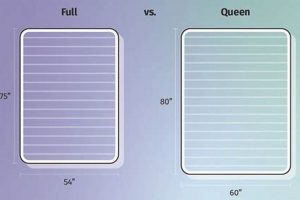
![Saatva vs Leesa Mattress: Which Bed Wins? [2024] Organic & Natural Mattress Buyer’s Guide: Non-Toxic Sleep Solutions Saatva vs Leesa Mattress: Which Bed Wins? [2024] | Organic & Natural Mattress Buyer’s Guide: Non-Toxic Sleep Solutions](https://mattressworldpa.com/wp-content/uploads/2025/07/th-1084-300x200.jpg)
